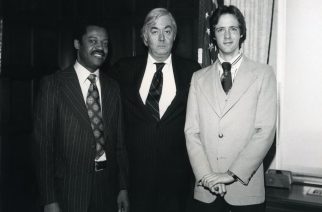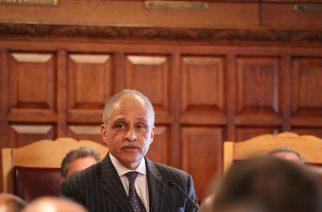
A goat carved into the stonework on the Million Dollar Staircase in the Capitol. The stone carvers who finished the building were allowed to fill in the spaces between the required carvings with their own inspirations. Many of the artists who shaped the sandstone were from Great Britain and Italy and carved figures from the legends and folklore of their homeland.
It could be the disembodied spirit of a depressive fruit stand owner. It could be an artist whose life work was marginalized. Or it could be a dutiful nightwatchman who still, after decades, refuses to abandon his post.
Many people who work in, or visit, the state Capitol have reported strange occurrences such as cold spots, flickering lights, unexplained noises and even floating orbs.
Whichever story grabs you, raises the hairs on the back of your neck, or rouses your sense of skepticism, the annual Office of General Service’s “Capitol Hauntings Tour” offers an in-depth look and historical context for some of the Capitol’s most grizzly incidents, legends and lore.
Through the month of October, the Plaza Visitors Center and OGS will be offering the popular tour that delves into the darker side of New York’s Romanesque Revival-style statehouse.
“People working late have seen an apparition crossing the hallway outside the Senate chamber,” says Stuart Lehman, education coordinator for the Capitol. During a recent tour, Lehman showed a reporter enlargements of historic photographs of the night watchman, Samuel Abbott, who perished in the fire of 1911, as well as photographs of “orbs” frequently correlated with paranormal entities.

Abbott was a 78-year-old Civil War veteran and the only casualty of the fire that destroyed much of the building in 1911, fueled by the expansive state library that was once housed in the Capitol. More than half a million books and artifacts were lost in the fire — with the notable exception of Iroquois artifacts that were left untouched, despite their display case and most of the surrounding area being engulfed in flames.
State workers still sometimes claim to hear keys jingling from Abbott’s belt or doorknobs rattling as he makes his rounds, still securing the building where he lost his life.
The tour takes visitors to the fourth floor, where a grizzly incident unfolded in 1890, an incident some say can still be seen unfolding, over and over as the tormented spirit of an Albany street vendor can be seen reliving his final moments.
“Two women were walking on the Senate steps near the fourth floor when they saw a flash of darkness,” says Lehman, describing the presumed suicide of a failed fruit vendor in the Senate staircase. The women looked down to see a man bleeding from the head. “They left the Capitol without looking back,” says Lehman.

The tour continues to the Assembly Chamber, the home of a large clock that was a feature of the original Assembly chamber, one of Lehman’s favorite artifacts. Does the clock hold some sort of spirit, lurking in the chamber seeking redress?
About 15 years ago, ghost hunters detected cold spots in the Assembly Chamber as they investigated the Capitol’s paranormal happenings. Unexplained sharp drops in temperature are frequently attributed to the paranormal by experts.
Could this be the posthumous work of William Morris Hunter, the artist whose life work — two great murals on the once-domed stone ceiling — still menacing the chamber?
Originally, the Assembly Chamber had a large dome ceiling that began to fail, eventually needing to be lowered for safety. Unfortunately for Hunter, who spent years planning and executing his artistic vision, the repairs of the ceiling required that the murals be covered.
The 40-foot paintings are still underneath the replacement ceiling, but years of neglect and water damage have eroded them to mere flakes of paint. Hunter later died mysteriously when out for a walk. Some say he fell, others say the insult of his life’s work being disrespected became too much for the artist to handle.

Lehman also tells visitors about the odd situations involving two U.S. presidents who visited Albany posthumously and how Abraham and Mary Todd Lincoln were not alone in their theater box the night the president was assassinated, and the role that historic moment played in the undoing of a Capital Region couple.
Lincoln, whose body took the journey to his final resting place by train, made a stop in the Capitol for a public viewing. Workers of the train line that carried him claim that on the anniversary of his trip through Albany, an apparition of the engine and car, both draped in black, can be seen tearing up the tracks toward Albany — “with thousands of blue coated skeletons seen filling the sky above it,” adds Lehman.

Another noteworthy presidential corpse that made a stop in Albany is that of Ulysses S. Grant. Grant and Lincoln are carved onto the same pillar on the Capitol’s “Million Dollar Staircase.” Grant’s body, which was on display in the Capitol for one day —August 4, 1885 — drew an estimated 50,000 mourners. Grant completed his memoirs in Wilton in Saratoga County about two weeks before he succumbed to throat cancer
While there is ample historic context for all of the tales ably told by Lehman, he likes to let the visitors decide for themselves if they think the litany of reported sightings are the product of legitimate paranormal activity, or just an old building’s mythology, cultivated over the decades.
If the whispers of the New York State Capitol’s dark history piques your interest, you can register to take the tour Monday through Friday afternoons at either 1 or 5:30 p.m. or Saturdays at noon, by visiting www.ogs.ny.gov or by calling (518) 474-2418.










